The Tip & Tail Of The Dart
Reproduced with permission of Classic & Sports Car magazine (July 2020)
Daimler SP250 XHP 438 and SP252
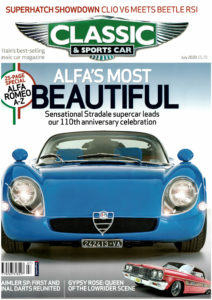
Classic & Sportscar
July 2020
The earliest surviving SP250 meets the newest DART that never was: the William Lyons-penned SP252
The red factory press and publicity Dart, XHP 438, now recognised as the oldest in existence, is not so much the first production SP250 but rather the last prototype of this unlikely breed of strangely lovable Daimler sports cars.
Never did a car go much better than it looked. Some might say that would not be difficult, yet the 2,650 people who saw beyond the bottom-feeding fish aesthetics of the new Dart discovered an otherwise ordinary sports car that was entirely redeemed by its delightful engine. And its throaty yet silky-smooth and superbly flexible 2½- litre V8 was one of the best of its kind anywhere in the world.
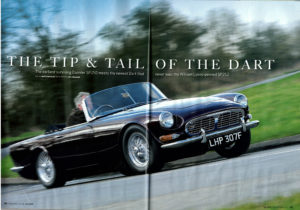
Classic & Sportscar – July 2020
The Tip & Tail Of The Dart
SP250 XHP 438 and SP252 LHP 307F
Pages 100-101
This tail-finned 122 mph two-seater was the last thing anyone expected from the hidebound works at Sandy Lane in Radford, Coventry, in the autumn of 1959. Yet it played no part in Sir William Lyons’ decision to acquire Daimler, Britain’s oldest car maker, from BSA seven months later in May 1960.
Quite the opposite: Lyons wanted Daimler for its production capacity to build more of his Jaguars, rather than for its dated range of homely looking saloons. In fact, he was known to reserve the least affection of all for the SP250 Dart, the model that had already bombed embarrassingly (and expensively) in the North American market for which it was intended.
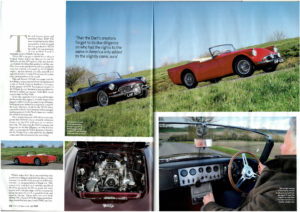
Classic & Sportscar – July 2020
The Tip & Tail Of The Dart
SP250 XHP 438 and SP252 LHP 307F
Pages 102-103
The reasons were not difficult to work out, given that Daimler was a virtually unknown marque in the USA with next to no service back-up. The fact that the Dart’s creators had forgotten to do due diligence on who had the rights to the name in North America (Chrysler, for the Dodge Dart) only added to the slightly comic aura that surrounded the poor thing.
Which makes it all the more surprising that Lyons was willing to entertain the idea of a new version of a car that had proved so stubbornly resistant to the generation of black ink. This completely restyled and suitably modified Daimler sports car would use much the same engine and underpinnings, and be constructed along the same lines with a glassfibre body and separate chassis.
Three such cars were built during 1961, ’62 and ’63 in the Jaguar prototype department but just one, chassis 100005, survives.
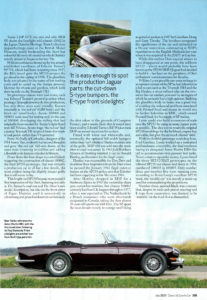
Classic & Sportscar
July 2020
The Tip & Tail Of The Dart
SP250 XHP 438
and SP252 LHP 307F
Page 105
Today LHP 307F, the one and only MkII SP, shares the limelight with chassis 100002 in the Jaguar Daimler Heritage Trust Collection (www.JaguarHeritage.com) at the British Motor Museum, neatly bookending the short but colourful life story of a model on which Daimler naively pinned its hopes in the late ‘50s.
With its confidence shored up by the already established excellence of Edward Turner’s 90˚ V8, which had been in testing since 1957, the BSA board gave the SP250 project the go-ahead in the spring of 1958. The glassfibre body was adopted in the name of low tooling costs and to speed up the design process; likewise the chassis and gearbox, which both drew heavily on the Triumph TR3.
Six prototype chassis were laid down, such was Edward Turner’s general practice when putting a Triumph motorcycle into production, but only three were used initially. Known internally as ‘the red car’ (GRP body) and ‘the black car’ (steel body), chassis 100000 and 100001 were used for testing and, in the case of 100000, developing the styling that had originally been mooted by Turner’s right-hand man Bill Wickes. At one stage ‘the red car’ had cutaway Triumph TR-inspired doors that made it look pedal-rather than V8-powered.
Percy McNally of Carbodies, designer of the FX4 Austin Taxi, evidently had second thoughts and gave ‘the red car’ full-size doors, at the same time trimming its tailfins and adding a flourish to its famous wheelarch blisters.
From there the final shape was established, triggering the construction of 100002, the final SP250 prototype, that was virtually a production car in all but a few details, the most evident being the slightly deeper grille that it still wears today.
This bright-red SP250’s became most people’s first impression of the Dart, featuring not in The Autocar’s road test and The Motor’s new model description, but also on the front cover of Vogue. Daimler used it extensively in advertising and press handouts (most famously the shot taken in the grounds of Compton Verney), and it seems likely that it would have been used by Edward Turner, Bill Wickes took XHP on several occasions for certain.
Fitted with wires and whitewalls and eventually, the optional full-width bumpers rather than ‘cat’s whiskers’ blades on either side of the grille, XHP 438 was sold into the trade after its road-test career. In 1961 Jack Brabham Motors of Dorking retailed it out to Donald Hartley, an illustrator for the Eagle comic.
Hartley was responsible for Dan Dare and doubtless drew inspiration from his Dart when he penned the January 1962 Eagle cutaway feature on the SP250 police cars that Daimler had been supplying to the Met since 1961.
After Hartley chopped in XHP for a Sunbeam Alpine in 1962 the ownership chain gets somewhat murkier, but chassis 100002 certainly had four UK keepers through to 1977, when it was exported to The Netherlands by a Dutch composer, who soon afterwards emigrated to Canada, taking the then almost 20-year-old sports car with him. The SP spent the decade mostly in storage until being acquired at auction in 1987 by Canadians Doug and Gary Titosky. The brothers recognised the significance of the car and embarked on a 30-year restoration, culminating in XHP’s repatriation to the English Midlands last year when it was acquired by the JDHT at Gaydon.
While this earliest Dart seemed to almost to have disappeared at one point, the stillborn SP252 – which would probably have been known as the SP250 MkII if Jaguar had decided to build it – has been on the periphery of Dart enthusiasts’ consciousness for decades.
William Lyons possibly saw some mileage in an uprated version of the SP he had inherited as a foil to cars such as the Triumph TR4 and the Big Healey; a more refined take on the two-seater fun-car market, powered by an engine of which he certainly had a high opinion. Building the glassfibre body in-house as a good way of avoiding the industrial problems associated with Pressed Steel and meant he would not be further beholden to BMC, which owned Pressed Steel, for his supply of SP bodies.
Lyons could also build economies of scale into the SP252 by using as many Jaguar parts as possible. The idea was to retain the original SP250 mouldings for the bulkhead, engine bay and cabin, but give the car much cleaner ‘skin’.
With his faithful prototype workshop boss, Fred Gardner, Lyons worked up a restrained and handsome convertible, the final rendition having an elongated Aston Martin DB4-like tail to accommodate twin pannier fuel tanks. Never a man to squander money, Lyons based the three SP252/MkII prototypes on the leftover SP250 test chassis laid down in 1958, numbered 100003 to 100005. Only number three and five were running cars; according to Brian Long’s excellent SP250 book, the ‘middle car’ was merely a mock-up used for contemplating the proportions.
Number three, painted black, was a runner that, despite its rack-and-opinion steering and E-type front suspension, was deemed to be ‘unstable’ on the road. It was dismantled.
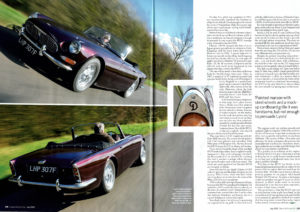
Classic & Sportscar – July 2020
The Tip & Tail Of The Dart
SP250 XHP 438 and SP252 LHP 307F
Pages 106-107
Number five, which was completed in 1963, was mechanically standard but finished to a high level of detail. Good enough to be viewed by Lyons at Wappenbury Hall, the country seat where prototype Jaguar styling traditionally received his yea or nay.
Painted maroon and fitted with steel wheels and a mocked-up cardboard radiator grille it was a handsome car, but not distinctive enough to persuade Lyons to give the SP250 concept a stay of exception beyond 1964.
Chassis 100005 escaped the fate of most Jaguar prototypes and was even shown to Colin Chapman and his team when they visited Browns Lane in 1964. A Jaguar takeover of Lotus was secretly in the offing: had Chapman not had last-minute cold feet, an early spin-off might have been a Daimler V8-powered Lotus Elan +2S. By all accounts, Chapman and his cohorts were much more impressed by the engine than they were by the SP252.
The one-off sat under a dust sheet at Browns Lane for the following three years. Then, in 1967, it acquired its ‘F’ registration mark (and a proper hood) before being sold off by Jaguar’s Lofty England to a particularly good repeat customer called Peter Ashworth, who wanted it for his wife. However, when the lady failed to bond with the MkII Dart it quickly found a new home, for £700, with Tom Sweet.
It still had its Perspex windscreen at that stage, but a glass ‘screen from a Skoda was later adapted to fit. I’m not sure when it acquired its wire wheels (a shame, because it looked tougher on the steels), but the rack-and-pinion steering conversion is a near ‘must’ on these cars and this was done relatively recently by model specialist Robert Grinter for last-but-one owner Laurence Jones. He sold the SP252 to Kevin Lindsell, who shared the car with his cousin Geoff Gammon.
That was where C&SC caught up the Dart MKII last year. But events moved quickly and it had soon gained a new custodian, Matt Pilkington of Pilkington Oils. He has allowed the JDHT to put the 252 on display at Gaydon.
I have always found the shape of the standard SP250 endearing rather than straightforwardly unattractive. Bug-eyed and guppy-mouthed, the Dart could never be mistaken for anything else and it assumes a unique allure because the car itself makes such a fabulous sound. The visual and aural appeal of the Daimler SP250 are strangely symbiotic.
Live with one for any length of time, as I did with a C-spec car, and the shape will grow on you anyway. What’s more, those who don’t know anything about cars tend to love the looks of the thing, with almost no exceptions.
With its fins, frills and superfluous mouldings, however, the SP250 as produced by Daimler was styled for a 1950s sensibility that was already on the wane. In contrast, Lyons’ interpretation Is so restrained and conservative that it walks a fine line between blandness and beauty, but it is a good-looking car with no bad angles.
Somebody spent a lot of money reproducing the original mock-up grille in chromed steel, with the added artistic licence of Daimler flutes. I would have gone with the simpler type used on 100003, even if it does look more like an MGB.
It is easy enough to spot the production Jaguar parts, such as the cut-down S-type bumpers and the front sidelights from the E-type.
Inside, it has an early E-type dashboard but has lost its big bus-driver sprung steering wheel in favour of a wooden job that tends to go with the rack-and-pinion conversion. The seats are standard SP, but the small rear bench has been abandoned in favour of a carpeted parcel shelf.
I have always enjoyed driving Darts and, apart from the steering, the 250 and the 252 are not very different once you get under way.
Despite the prosaic-sounding suspension-wishbones up front and a leaf-sprung live rear axle – you can hustle them with confidence, the benefits of the rack on the 252 being most evident at lower speeds, when it is much lighter.
You feel you are sitting ‘on’ these cars rather than ‘in’ them but, while it doesn’t pretend to be an Elan or even an E-type, the Dart is stable, safe and undramatic to drive in a manner that is always enjoyable, at least within the limits of the suspension travel on a bad road. Interestingly, the SP252 is the only Dart I have driven where the door actually has sprung open on the move!
The engines really are turbine-smooth and uniquely high-revving for 1960s V8s, yet have the sort of limousine torque that means you can drive ever so quietly and politely in top from 1000 rpm. The secrets of this refinement and efficiency lie in its oversquare dimensions; the hemispherical combustion chambers; short, light pushrods; and an inlet manifold design that allows for even mixture distribution.
The gearbox is as ordinary as the engine is distinguished, but it goes a long way towards making up for its easily beaten synchromesh by having such well-plotted ratios that third gear is good for 100 mph.
The fate of the SP252 lay firmly in the financial and practical issues the car raised: it was powered by an engine that was tooled up for no more than 140 units a week and was already proving popular in the Jaguar Mk2-based Daimler V8-250 saloon. At a time when Jaguar could not produce enough E-types to satisfy demand, it didn’t make sense to become distracted by a car that was more expensive, in terms of man-hours, to build.
The good news is that the SP252 survives as a fascinating ‘what might have been’ in the colourful story of this misconceived, and initially even misnamed, glassfibre-bodied two-seater that has many more devoted fans today than it had in period. I remain one of them.
Words: Martin Buckley
Photography: Will Williams